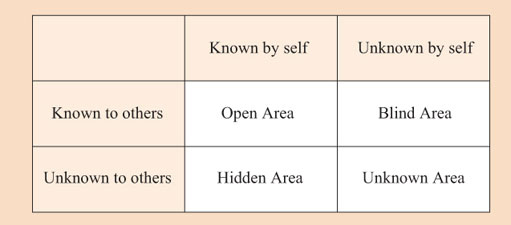2.3 Using your feedback
What do you do with the feedback once you have it? Rather than just make notes about it, in this section you will be introduced to a tool for exploring the impact that feedback can make. This is known as the ‘Johari Window’’.
The Johari Window is named after its originators, Joseph Luft and Harrington Ingram (for some reason there is only ever one ‘r’ in ‘Johari’). An outline of a Johari Window is shown in Figure 5. Have a look at this now. The ‘window’ covers the four white areas in the diagram; together they look something like the panes of a window – hence its name.
The open area, top left, is for what you know about yourself, and are happy to share with others. An example might be if you are happy to tell someone about the strengths that you bring to your job and some of the qualities you are proud of.
The blind area covers what other people know about you, but of which you are not aware. You might, for instance, be unaware that someone finds you supportive, thinks you are great at problem-solving or that you have an annoying habit (and most of us do!).
The hidden area, bottom left, is what you know about yourself, but would prefer other people not to know. This could include opinions that you do not want to share with others, as well as any weaknesses that you feel you have – maybe due to a lack of confidence.
In the bottom right-hand corner is the unknown area. This represents aspects that are as yet unknown to anyone – both to you and to others. This might include hidden talents, unconscious feelings, or abilities and qualities that have never been brought to the surface – and there will be some of these for us all. In other words, it may represent as yet unknown resources that could help your learning.
The contents of each of these areas changes as we, for example, learn how others see us, gain sufficient confidence in something to share it or discover unexpected skills.
One way of deliberately trying to expand the open area of your Johari Window is to ask other people to tell us what they know about us – in other words, ask them for feedback.
We can reduce the size of the unknown area by looking into ourselves (self-discovery), or by finding out about ourselves with the help of others (shared discovery).

